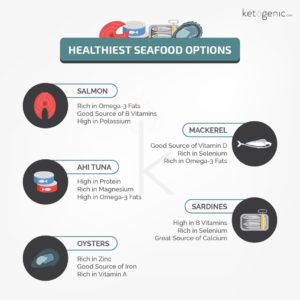
As the macronutrient famed for its ability to build lean muscle mass, protein is probably the most important part of a meal. It’s the stuff DNA is made of, the building blocks of life, and without it, we would literally crumble into dust. Not all protein sources are created equal though, so let’s discuss the top 5 protein sources to enjoy on a keto diet.
1. Grass-fed meat

Grass-fed beef, lamb, goat, bison, veal, and venison are all great sources of protein on keto. A good old rib-eye steak is a typical favorite on the ketogenic diet because as a fattier cut of steak, it wins on both the flavor-front and the nutrient-front. Other equally delicious but cheaper cuts of steak include picanha (sirloin cap), flat iron steaks, and more.. A cut of rib-eye steak contains 17.7g of protein per 100g.
2. Poultry
Poultry includes chicken, turkey, pheasant, goose, duck, and others. Poultry sits nicely within a ketogenic diet, offering a nice amount of protein per serving. The tastes of poultry are typically well accompanied by other ketogenic foods.
When choosing poultry, try to opt for fattier cuts of meat, i.e. opt for chicken thighs over chicken breast. Duck is another great alternative to chicken breast because it also has a higher fat content. 100g of chicken thighs supply 24g of protein.
Avoid leaner meats, like turkey, unless you are adding an additional fat source or strictly need to add more protein to your diet.
3. Eggs
Eggs are an absolute staple on the ketogenic diet. Eggs are the king of breakfast time with the standard bacon and egg duet. They make for great snacks (like boiled or deviled eggs) and can even accompany a tasty steak for dinner.
Fried, poached, scrambled, you name it there is a method of cooking an egg to suit each person on each occasion. Coming in at 6g of protein per 1 large egg, you cannot go wrong with including these nutrient-dense taste-bombs into your diet. Being high in protein isn’t the only bonus to this story, eggs are also a winner when it comes to micronutrients.

4. Organ Meat
Commonly known as offal, an acquired taste to many, organ types of meat offer good amounts of protein. From chicken livers (23g protein/100g) to ox tongue (16.7g protein/100g), there are many ways in which organ meats can spice up your diet.
Ranging from hearts, livers, tongues to kidneys and brains, there is a great variety to choose from. The odds are that if you don’t like one type of organ meat from one animal then you may like it from another. Aside from their protein content, organ meats are particularly high in micronutrients.
5. Fish
 With its fatty acid composition (omega 3:6), fish is a firm favorite on the list of protein sources on the keto diet. With 100g of salmon coming in at 19.4g of protein, this is a sure-fire way to add the taste and the gains to your ketogenic diet.
With its fatty acid composition (omega 3:6), fish is a firm favorite on the list of protein sources on the keto diet. With 100g of salmon coming in at 19.4g of protein, this is a sure-fire way to add the taste and the gains to your ketogenic diet.
Changing the menu with fish can often be the difference needed to keep things interesting when pursuing a new way of eating.
Adding fish will not only keep up the supply of the brain and heart-healthy fatty acids it will also aid the body in rebuilding and repairing itself, making your quest for health on a ketogenic diet all the more fruitful.
Final Takeaways About Keto Protein Sources
The above protein sources all have their place within a keto diet. For some, eggs are for breakfast most days, with fatty fish and grass-fed beef taking over lunch and dinner other days. By eating a variety of protein sources, you can maximize the amino acid profile and nutrient diversity on your keto diet.
What Are your Favorite Keto Protein Sources?
Are you more of a steak or salmon person? How do you prefer to get your protein on keto? Comment below and share with the community!










Eggs, canned cod liver, bison, love those 3 protein sources.
DELISH!